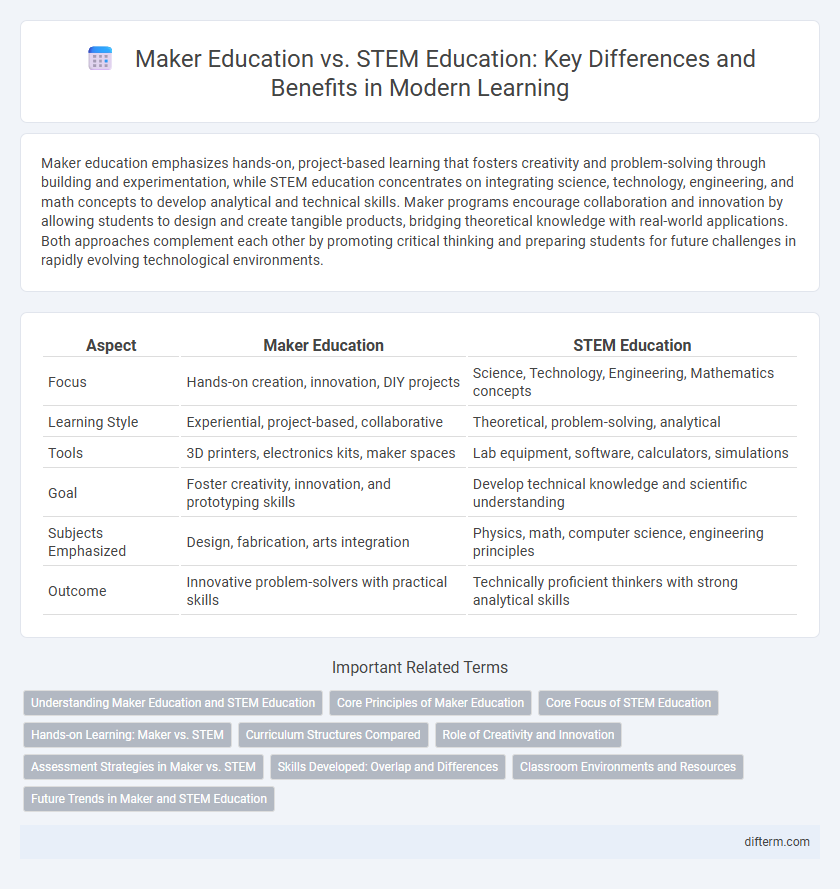Maker education emphasizes hands-on, project-based learning that fosters creativity and problem-solving through building and experimentation, while STEM education concentrates on integrating science, technology, engineering, and math concepts to develop analytical and technical skills. Maker programs encourage collaboration and innovation by allowing students to design and create tangible products, bridging theoretical knowledge with real-world applications. Both approaches complement each other by promoting critical thinking and preparing students for future challenges in rapidly evolving technological environments.
Table of Comparison
| Aspect | Maker Education | STEM Education |
|---|---|---|
| Focus | Hands-on creation, innovation, DIY projects | Science, Technology, Engineering, Mathematics concepts |
| Learning Style | Experiential, project-based, collaborative | Theoretical, problem-solving, analytical |
| Tools | 3D printers, electronics kits, maker spaces | Lab equipment, software, calculators, simulations |
| Goal | Foster creativity, innovation, and prototyping skills | Develop technical knowledge and scientific understanding |
| Subjects Emphasized | Design, fabrication, arts integration | Physics, math, computer science, engineering principles |
| Outcome | Innovative problem-solvers with practical skills | Technically proficient thinkers with strong analytical skills |
Understanding Maker Education and STEM Education
Maker education emphasizes hands-on, project-based learning where students design, build, and iterate physical or digital creations, fostering creativity and problem-solving skills. STEM education integrates science, technology, engineering, and mathematics through interconnected curricula to develop critical thinking, analytical abilities, and technological literacy. Both approaches aim to enhance student engagement and real-world application but differ in focus: Maker education centers on creation and experimentation, while STEM prioritizes disciplinary knowledge integration.
Core Principles of Maker Education
Maker education emphasizes hands-on creativity, iterative problem-solving, and collaborative learning, fostering innovation through building and experimenting with tangible projects. Its core principles prioritize learner-driven exploration, interdisciplinary integration, and the development of practical skills in real-world contexts. This approach contrasts with STEM education's structured focus on science, technology, engineering, and mathematics content mastery and standardized assessments.
Core Focus of STEM Education
STEM education primarily centers on developing skills in science, technology, engineering, and mathematics through structured curriculum and problem-solving methodologies. It emphasizes analytical thinking, mathematical modeling, and technology integration to prepare students for technical careers and innovation. Unlike Maker education, which fosters creativity and hands-on project building, STEM education prioritizes foundational knowledge and systematic application of scientific principles.
Hands-on Learning: Maker vs. STEM
Hands-on learning in Maker education emphasizes creative problem-solving through building physical projects, encouraging innovation and iterative design. STEM education integrates hands-on activities with theoretical concepts in science, technology, engineering, and mathematics to develop analytical and technical skills. Both approaches foster experiential learning, but Maker education highlights open-ended creation while STEM focuses on structured skill application.
Curriculum Structures Compared
Maker education emphasizes hands-on, project-based learning that integrates art, design, and engineering through open-ended creation, fostering creativity and problem-solving skills. STEM education structures its curriculum around the systematic study of Science, Technology, Engineering, and Mathematics, focusing on theoretical knowledge and practical applications within each discipline. Both curricula promote interdisciplinary learning, but maker education prioritizes experiential learning with flexible, student-driven projects, whereas STEM education relies on structured, standards-based content aligned with academic benchmarks.
Role of Creativity and Innovation
Maker education emphasizes hands-on learning and fosters creativity by encouraging students to design, build, and experiment with tangible projects, promoting innovative problem-solving skills. STEM education integrates science, technology, engineering, and mathematics to develop analytical and technical competencies but often underrepresents open-ended creative exploration. Combining Maker education's creative innovation with STEM's rigorous knowledge base enhances students' ability to develop original solutions and adapt to complex challenges in the 21st-century workforce.
Assessment Strategies in Maker vs. STEM
Assessment strategies in Maker education prioritize process-oriented evaluation, emphasizing creativity, problem-solving, and iterative design through portfolios, reflective journals, and peer reviews. In contrast, STEM education assessments often focus on quantitative measures, such as standardized tests, quizzes, and performance tasks that evaluate specific content knowledge in science, technology, engineering, and mathematics. Maker education fosters informal, formative assessments encouraging student self-assessment and collaboration, while STEM assessments tend to be more summative, focusing on mastery of defined learning objectives.
Skills Developed: Overlap and Differences
Maker education and STEM education both foster critical thinking, creativity, and problem-solving skills, emphasizing hands-on learning and innovation. Maker education uniquely promotes practical skills such as fabrication, design thinking, and iterative prototyping, while STEM education concentrates more on foundational knowledge in science, technology, engineering, and mathematics. Together, they complement each other by combining conceptual understanding with real-world application, preparing students for complex interdisciplinary challenges.
Classroom Environments and Resources
Maker education transforms classroom environments into hands-on innovation hubs by integrating 3D printers, robotics kits, and craft supplies that foster creativity and problem-solving skills. STEM education primarily emphasizes structured instruction in science, technology, engineering, and math using labs, computer software, and standardized curriculum to build analytical thinking. Both approaches require flexible learning spaces, yet maker education thrives on open-ended projects and collaborative tools that encourage experimentation beyond traditional STEM resources.
Future Trends in Maker and STEM Education
Future trends in Maker and STEM education emphasize integrating hands-on, project-based learning with advanced technologies such as artificial intelligence, robotics, and virtual reality to enhance student engagement and skill development. Educational institutions increasingly adopt interdisciplinary curricula that combine coding, engineering, and design thinking to prepare learners for evolving job markets. Investment in scalable maker spaces and digital platforms promotes equity by providing diverse access to resources vital for fostering innovation and critical problem-solving abilities.
Maker education vs STEM education Infographic

 difterm.com
difterm.com